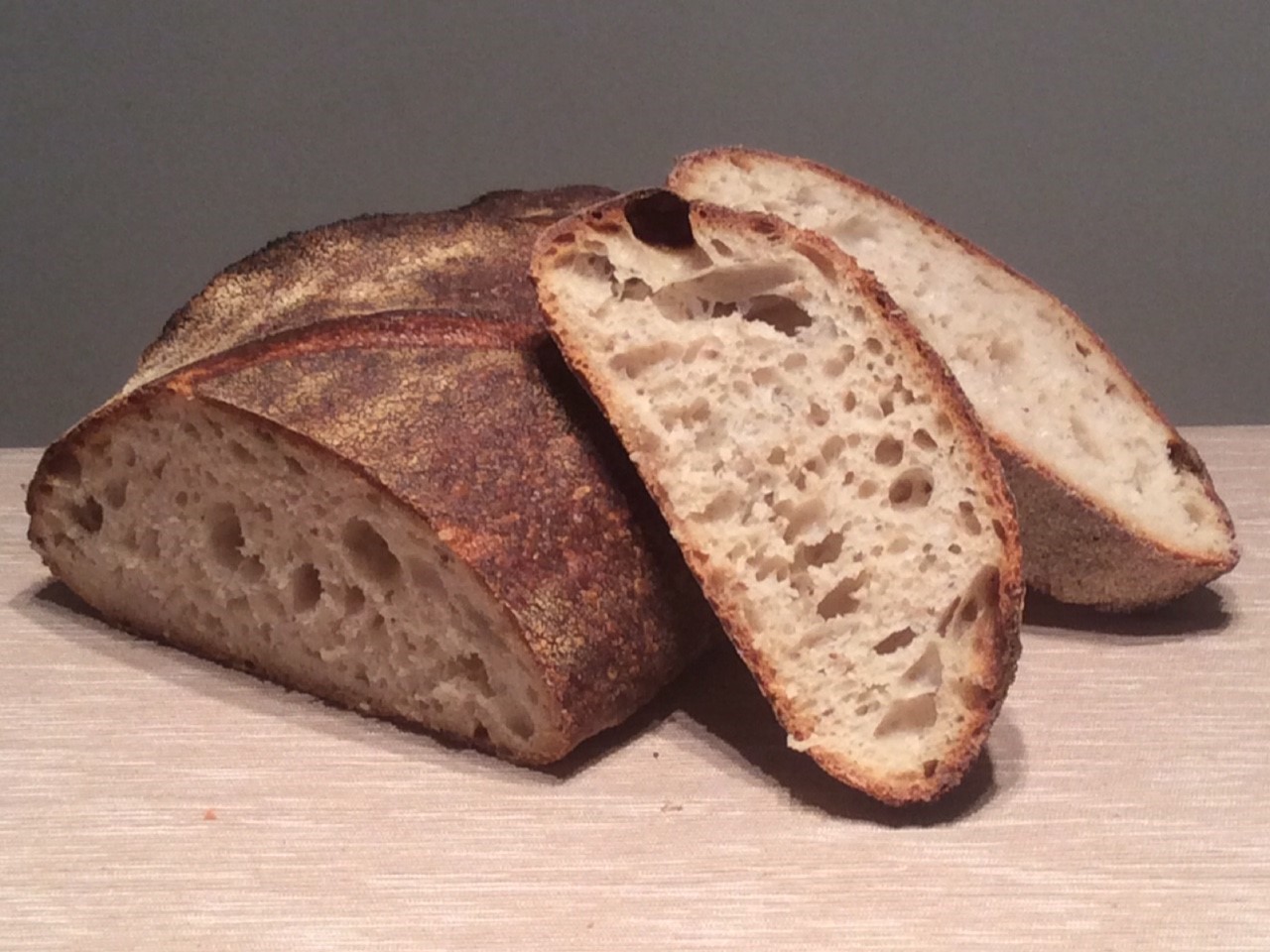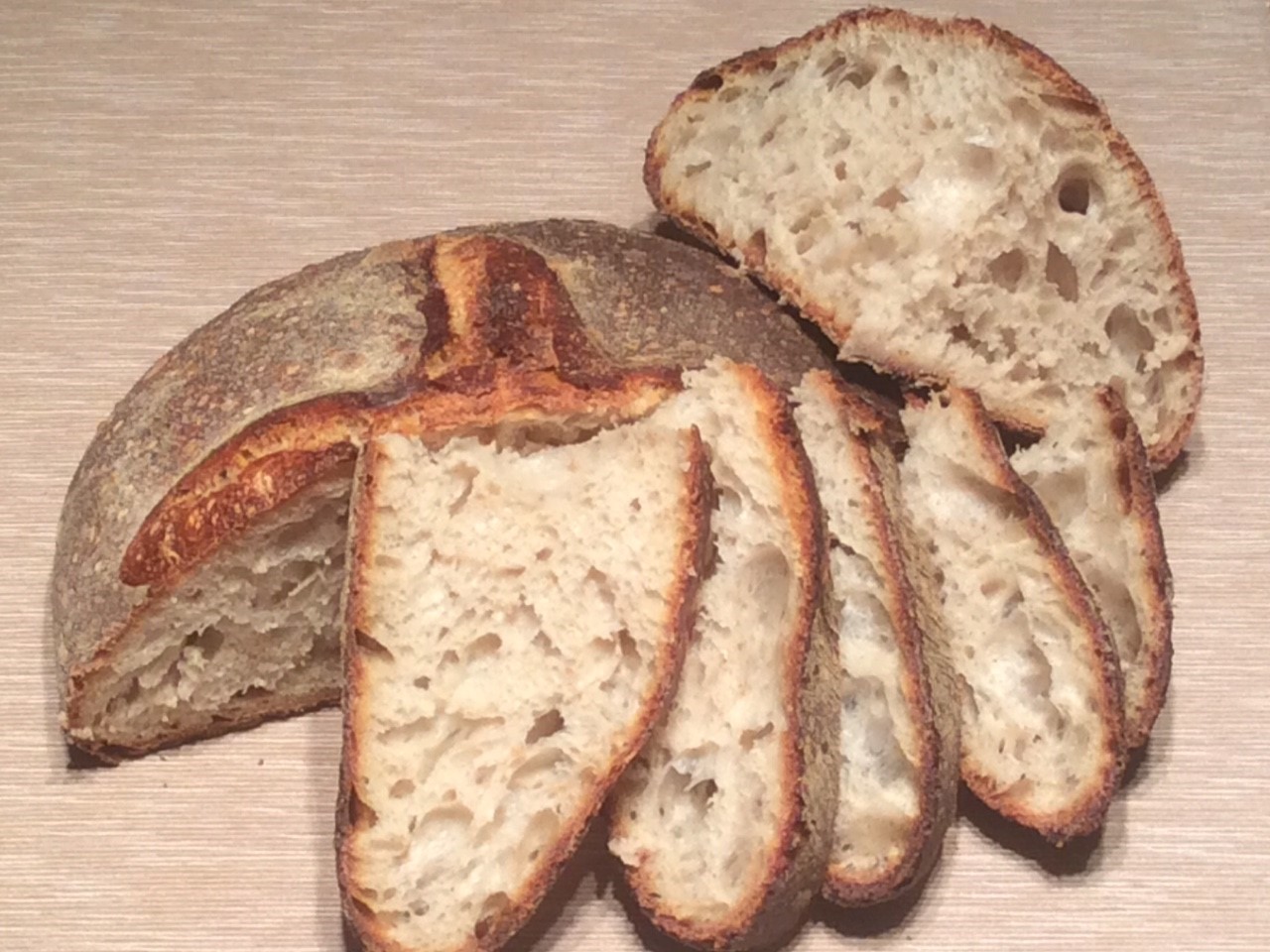
On the way to getting "ears" with 1-2-3 Sourdough

It looks like I've taken to documenting my progress with a variation on a 1-2-3 Sourdough most weekends.
I'm sticking with the same formula, not be cause I lack imagination, but I want to see what small changes to my method make to consistent ratios of ingredients. My previous attempts are here, here, here and here.
This week I made a boule and a bâtard, and it's the latter that I'm picturing today. Here's the total formula for each loaf, including the build for the final pre-ferment:
- Allinson strong bread flour: 479g (96%)
- Stoneground wholemeal flour: 21g (4%)
- Water: 327g (65%)
- Salt: 11g (2%)
- Diastatic malt: 4g (1%)
- Seed starter: 35g (7%)
A abbreviated summery of the method, up to the shaping:
- Make a pre-ferment at 58% hydration 12 hours before use;
- Autolyse flour and water for 30 minutes;
- Add preferment, diastatic malt and salt;
- Mix in a Kitchenaid for 8 minutes to achieve a reasonable 'window-pane';
- Prove at 23°C (73°F) for 3.5 hours, with stretch & folds at 20, 40, 60 and 80 min;
- Bench-rest for 15 minutes;
- Shape, place in linen-lined bannetons, sprinkled with ground rice.
The tension achieved while shaping of this bâtard could have been a bit better.
I had a good result last weekend with retarding the dough overnight. This weekend I went for a much longer retard, and a slightly lower oven temperature:
- Retard the bâtard at 4°C (39°F) for 35 hours, wrapped in a plastic bag;
- Preheat a heavy baking stone to 260°C (500°F) for 45 minutes;
- Change to bottom-heat only, once oven had reached temperature;
- Sprinkle the base with cornmeal and transfer to baking stone;
- Bake with steam at 230°C (450°F) for 15 minutes;
- Bake without steam at 220°C (425°F) convection for 30 minutes;
- Switched off the oven, leave door ajar with the loaf on the stone for 10 minutes (because it didn't sound hollow enough).
I guess you could say that this is the first time I've achieved something approaching an ear! I also go some blisters in the surface of the dough, but I still want more oven spring.

Next time, my plans are:
- Omit the diastatic malt, to see if this reduces the darkness of the bake at all;
- Reduce the bulk fermentation time to, say, 2.5 hours;
- Prove at 22°C (72°F), rather than 23°C;
- Repeat the extended retard after shaping.
NB: I retarded the boule I made at the same time at 4°C (39°F) for just 16 hours and baked in a La Cloche, this came out ok, but not as much oven spring as I achieved last week.

I really appreciate the comments and advice received on previous bakes - they are really helpful. Please keep them coming :-)
By the way, for those using social media, I also Tweet my bakes (and other stuff) from @ctwangel and I'll follow-back other bakers who are kind enough to follow.


good but i suspect that the dough was over proofed in the fridge and that is why the spring and bloom were retarded:-) The hardest thing to learn .about bread baking is when the dough is ready to be baked, When it is shaped in a container, because of its concave shape, it is hard to know when the dough is properly proofed.. A tiny inch oi rise in a basket may be 100% proof - and over proofed. For the longest time I had the same problem until I published pictures of the before and after proof of the dough. I thought I was at 100% for a white bread (too much by the way) and Mini Oven took one look at the pictures and said it was massively over proofed at least 150%. The crumb looked good like yours but the bloom,spring and ears were missing.
To get ears you have to crank the razor over to 30 degrees off parallel to the top of the dough and use a curved blade.
You are getting there.and it is fin to see your experiments.
Happy baking
Thanks, Dabrownman, very helpful comments. I'm presuming that if I cut-down on the bulk ferment then the dough will have a longer window of opportunity when retarded.
I'm using a curved blade in a lame, but not getting the angle right all the time. Mind you, I'm finding it much easier to slash the dough when it's straight from the fridge.
Many thanks, and happy baking! Colin.
at all because if I do, it will over proof in the fridge within 8 hours if I do a shaped retard at 36 F. The thing to remember about the shaped retard is that it takes a few hours for the dough to cool down to the fridge temperatures where the LAB and yeast are very slow to do anything. So most of the proofing happens in the first 4 hours and not much after that. I'm guessing that your 35 hour retarded loaf was likely over proofed at the 8 hour mark..
I finally went to 10% pre-fremented flour , no bulk ferment, doing a bulk retard of 18-24 hours, pre-shaping gently right out of the fridge and letting it warm up for an hour, final shaping gently and proofing for about 45 minutes until the dough rises 50% (not 100%) before baking. Great spring, bloom and ears but i think the holes aren't quite as big. I rarely make white bread so holes don't matter much to me - but I do want an open, light, moist crumb for sandwiches
Happy baking.
Many thanks. If you don't do a bulk ferment, do you just mix, do some stretch-and-folds (or similar) and then retard, or just rely on a high hydration to do most of the gluten formation? Thanks, Colin.
doing 4 sets of slap and folds of 30 slaps each on 30 minute intervals and 2 sets of stretch and folds of 4 stretches each so 3.5 hours of gluten development ( at least 86 F in the kitchen) then bulk ferment straight away afterwards I do have high hydration dough that helps too.
That's a really helpful clarification. Many thanks. :-)
The slashes in your crust opened up quite a bit. What makes you dissatisfied with the oven spring?
Thanks Mixinator. Kind of you to say. It may be just that I am on the competitive side, but I think there is considerable room for improvement. I guess you could say that my boules are still a bit too much like hemispheres, compared to some of the bakes I see on here. Happy baking! Colin.
....when you omit the diastatic malt. I bought an amount some time ago and I struggle to see any benefit other than a darker colour to the loaf.
Cheers
Thanks, Aroma.
The purpose of adding diastatic malt is the active enzymes (diastase) release sugars from the flour / starch. This should promote yeast growth and promote a darker crust, as you say.
I'm wondering whether it is increasing my proofing speed and giving me a rather dark crust than I want, which are the two areas that I'm trying to sort out.
At 1% of the total formula, I doubt that omitting diastatic malt in this loaf wilk have a massive effect, but it will be interesting to see.
Happy Baking! Colin.
The most millers add barley malt to their white flour in it. If you mill your own flour and sift off the hard bits, then you might add .6 of 1% malt depending on how white the flour is. White straight flour is 72% extraction with most patent flours made from it. Chances are the the malt isn't needed for your recipe with a decent autolyse and the flour you use.
Happy baking
Many thanks for the advice on this. I suspect adding diastatic malt is gilding the lily a bit. Happy baking. Colin,
Just to be pedantic, Colin, the diastatic malt is 0.76% - using bakers' maths, not 1%. 4g divided by (500g flour + 22g flour in levain).
The 4 g of malt is sprouted barley flour itself so 4 / 426 = .76%
Thanks Ruralidle and Dabrownman. Pedants rock! Happy baking! Colin